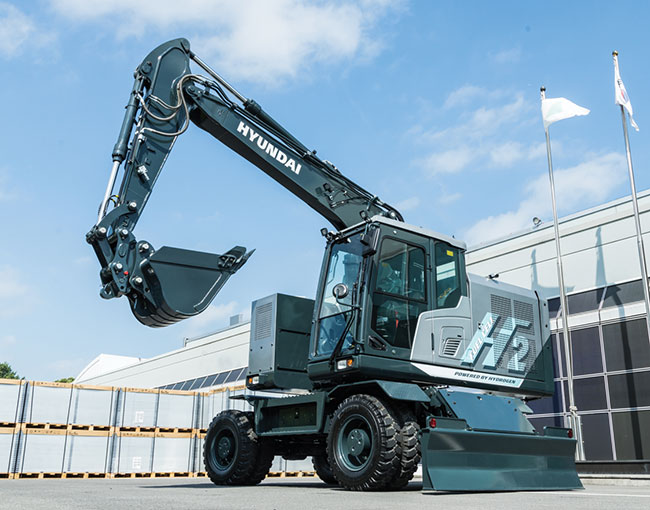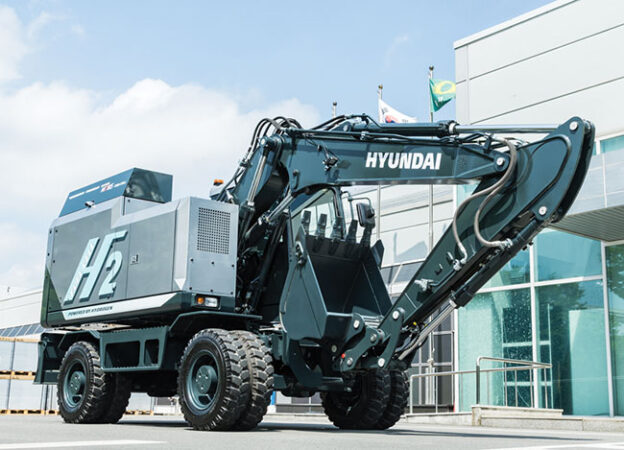
Hydrogen ramps up
By Treena Hein
Features Rental Equipment Tech tipsA look at the hydrogen-powered equipment already available...and what’s ahead.
 Most construction OEMS have at least concept versions of hydrogen-powered equipment.
all Photos: snowbird rentals
Most construction OEMS have at least concept versions of hydrogen-powered equipment.
all Photos: snowbird rentals While many still consider hydrogen to be a “fuel of the future,” it’s already here – and at a rental store near you. It promises a zero-emissions solution without some of lithium’s limitations.
The EODev GEH2 hydrogen generator is currently being distributed in North America by Generac Power Systems to such dealers as United Rentals, says Stephanie Rodgers, Generac’s senior public relations manager, who are then able to resell or rent. Generac does not disclose how many other rental firms may be among its dealers. We do know, however, that demand for hydrogen-powered products is growing. Both rental store commercial and DIY customers may increasingly want to rent hydrogen-powered equipment in order to be environmentally friendly (no carbon emissions) but also because the technology is already better on some performance fronts.
EODev chief marketing officer, Thibault Tallieu, says their hydrogen gensets have an electrical efficiency of 55 percent, much higher than the 20-to-30-percent efficiency of internal combustion engine gensets. Hydrogen combustion motors run very clean, without even slight darkening of engine oil over long periods of time. Hydrogen fuel cells have a rapid charging time that beats lithium electric by a mile. Refueling with H2 gas is very quick, just minutes, and Tallieu reports that availability of gas is getting better every day. He explains, “Transportation is easily handled by all gas companies (Linde, Air Products, etc.) just like any other gases. They have been doing it for a very long time as hydrogen is already widespread in the steel, fertilizer, refinement and medical industries.”
“The hydrogen charging infrastructure is still immature for now in some markets, but it will be improved through R&D from many companies and government organizations,” notes Hyundai Genuine senior researcher, Soonkwang Kwon.
Design and cost
Where to put hydrogen storage tanks on machines can be a bit of challenge. The tanks are generally larger than those for other types of fuel. Tallieu says tank size for their gensets depends on gas pressure and load profile, but most bundles will last for a workday. Consumption at 80 percent load is about 3.8 kilograms of hydrogen per hour. Equipment OEMs are already innovating to address the challenge of on-board hydrogen fuel storage. Conversations at ConExpo revealed plans to develop shaped fuel tanks for hydrogen that can store the fuel in a carbon-fibre-walled tube that runs around the engine compartment.
The capital cost of hydrogen tech, says Tallieu, is balanced by a proper leasing schedule, subsidies and decreasing operational costs. EODev is working on a range of higher power gensets, up to over a megawatt. “Demand is increasing fast,” Tallieu reports, “for zero-emission products.”
Generators are a logical first choice for development of hydrogen technology as they don’t face the vibration, contamination and other issues that moving equipment faces. However, that hasn’t stopped other firms from making hydrogen-powered excavators and much more.
Cummins
Cummins has gone the route of creating a spark-ignited “fuel-agnostic” common base engine platform with cylinder heads and fuel systems specifically tailored for hydrogen, natural gas, diesel, methane and other biofuels. The company showed a 15-liter version of this platform at ConExpo. It boasts a significant increase in power density, states Cummins, in a more compact installation envelope, “enabling OEMs to increase machine capability and productivity with no impact on running cost.” The hydrogen version of the engine has ratings from 400-to-530 horsepower and a peak torque of 2,600 newton-meters. Jeremy Harsin, Cummins off-highway marketing director, reports that the list of OEMs interested in hydrogen internal combustion engines continues to grow. “We have already publicly announced the signing of a memorandum of understanding with Buhler Versatile, a Canadian-based company, to evaluate our H2-ICE engines in their machines,” he says. “This adds to a long list of on-highway market announcements we have made regarding this technology. The customer pull is definitely there
and strong.”
Looking ahead to the further rollout of hydrogen tech, Harsin notes the general construction industry view is that small, compact equipment will trend to electric as it will support the duty cycles of those units. But Cummins sees potential developing H2-ICE in medium- and heavy-duty applications. “Within this space the typical market drivers and infrastructure considerations will be applied,” says Harsin. “We are seeing interest from a wide variety of application types, with probably the most notable construction segments being earthmoving and port support equipment.” When asked about timelines, Harsin says Cummins is following a general guideline of seeing the opportunity to commercialize H2-ICE within this decade.
“Most of the customer discussions we have for off-highway indicate that non-diesel machine production will continue to be a small percentage of the total for still some time,” he explains. “Off-highway OEM volumes are lower than on-highway to start, then considering a percentage of that which will transition, having a low-carbon option that lets them maintain commonality with the diesel platforms makes good sense. With H2-ICE, the OEM can maintain the same drivetrain as their diesel-powered equipment from the engine back. The OEMs just need to install the H2-ICE engine system and the focus then turns to packaging H2 tanks on the machines. While this isn’t necessarily an easy task, it does offer the OEMs a great opportunity to pace their engineering efforts until wider market adoption occurs.”
He adds, “What we cannot reiterate enough is that advanced diesel is still very much relevant in off-highway markets. The market demands dependability, reliability and versatility, which diesel allows. Today’s lead emission engines are very eco-friendly compared to legacy equipment in the field and future diesel enhancements will only serve to improve upon current. Advanced diesel platforms also serve as the base scale to support alternative fuels such as hydrogen to develop.”
Hyundai
Hyundai Genuine has created a hydrogen-powered concept excavator, the HW155H, and is working on a hydrogen-powered wheel excavator and a five-ton forklift. Kwon explains, “We think that a key factor of any alternative-powered machine is the ability to work consecutively without interruption. The HW155H will offer its users eight working hours on a single charge. We redesigned the upper body to accommodate hydrogen storage and we adopted 700 bar-capable hydrogen storage which is known as maximum pressure among previous commercialized equipment. The good balance between efficient space layout and optimal storage size was one of our achievements.”
He adds that Hyundai has conducted exhaustive research on how to efficiently use hydrogen and hydrogen power safely, making this a top priority. The hydrogen power pack of the HW155H was developed in collaboration with the Hyundai Motors, based on the hydrogen power pack that has been used in the Nexo, HMC’s first dedicated hydrogen-powered SUV. “We utilize the hydrogen leakage detection sensor and sophisticated control algorithms to secure the safety of using the hydrogen power system,” says Kwon. “We also conduct test case scenarios to validate all of the safety features onboard the machine.”

Some engines can run on a variety of fuels including natural gas and diesel as well as hydrogen.
Zoomlion
In December 2022, China-based Zoomlion launched 32 new lithium battery and hydrogen energy equipment products across many construction areas including concrete pumping, mixing trucks, aerial work, earthmoving, mining machinery and industrial vehicles. Zoomlion also has created an hydrogen-powered 45-megapascal hydraulic drive piston compressor and has introduced two new heavy-duty general chassis products, for electric and hydrogen use.
Caterpillar
In late 2021, Caterpillar announced the launch of various products that can be configured to operate on natural gas blended with up to 25 per cent hydrogen. At the 2022 Caterpillar Investor Day in May last year, Joe Creed, Caterpillar group president of energy and transportation, noted that their Solar gas turbine generator sets have had the capability to run hydrogen blends since 1985. “Today,” he stated, “both our gas turbines and reciprocating engine generator sets can operate on 100 percent hydrogen.”
JCB
JCB introduced a hydrogen combustion engine backhoe in May 2021. The firm also tested hydrogen fuel cells to power its 220X excavator over 2020 and 2021, but concluded that they were currently too complicated and costly for the off-highway market.
Sany
In February 2022, five Sany hydrogen fuel cell mixer trucks, the first batch of this type of truck ever delivered in the world, arrived at Yueyang Communications Construction Investment Group in China for urban construction use.
Volvo
In 2022, Volvo Construction Equipment started testing the world’s first hydrogen fuel cell articulated hauler prototype, the Volvo HX04. It’s charged with 12 kilograms of H2 in about 7.5 minutes, enabling about four hours of operation.
So it looks like hydrogen is about where lithium electric was 20 years ago. Given its faster charging and ability to power heavier equipment, this could be a technology for rental stores to keep their eyes on.
Hydrogen power in review
There are two types of hydrogen power, combustion and fuel cells. With either, the only emission is a small amount of water vapour.
Combustion engines are similar to a diesel engine, with compressed hydrogen gas flowing through fuel lines into the cylinders and then ignited by spark plugs. They are sometimes referred to as H2-ICE engines.
A hydrogen fuel cell has negative and positive electrodes on either side of an electrolyte. H2 gas is fed to the negative terminal and air to the other, resulting in a continuous flow of electricity to drive an electric motor.
Print this page
Leave a Reply